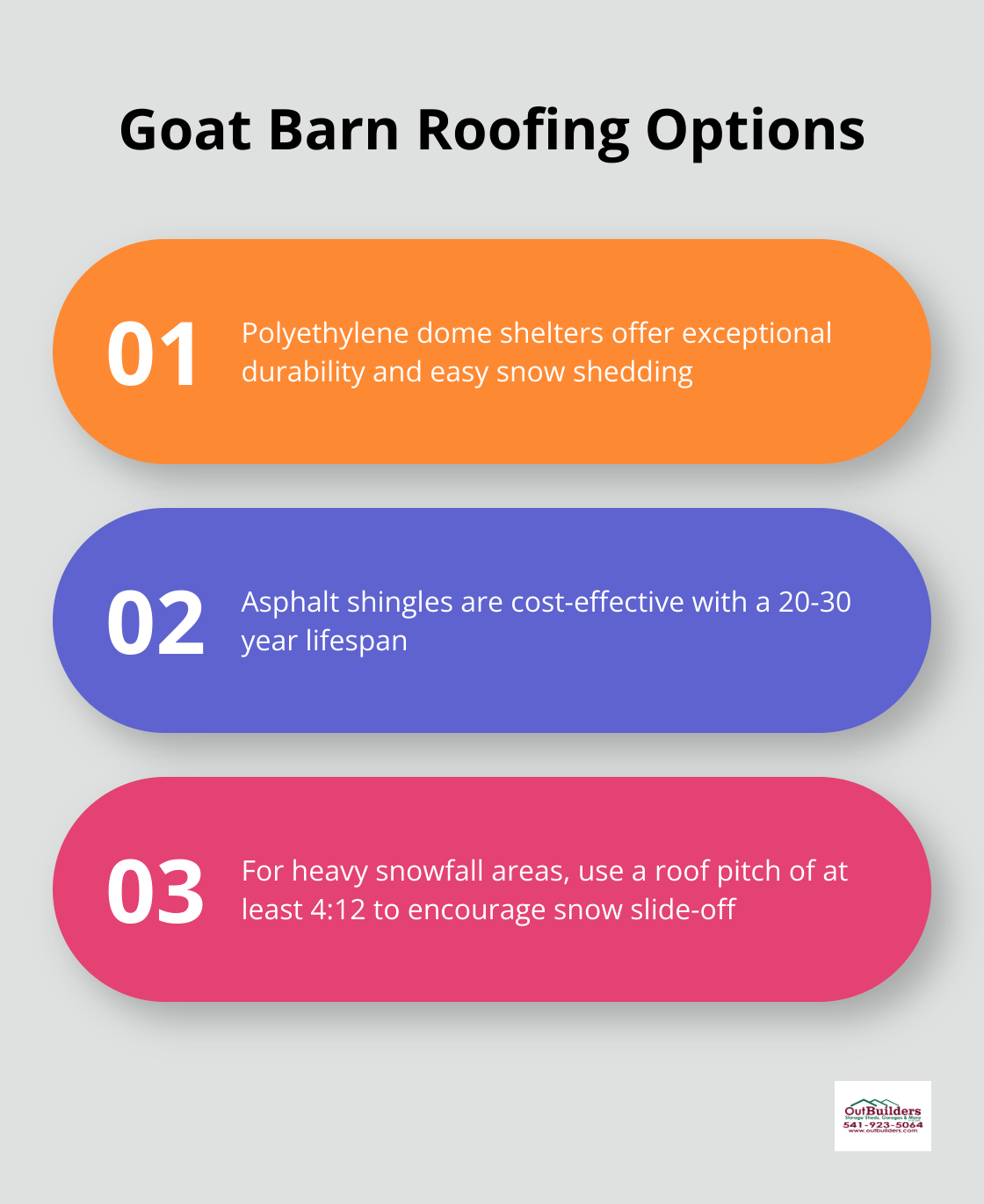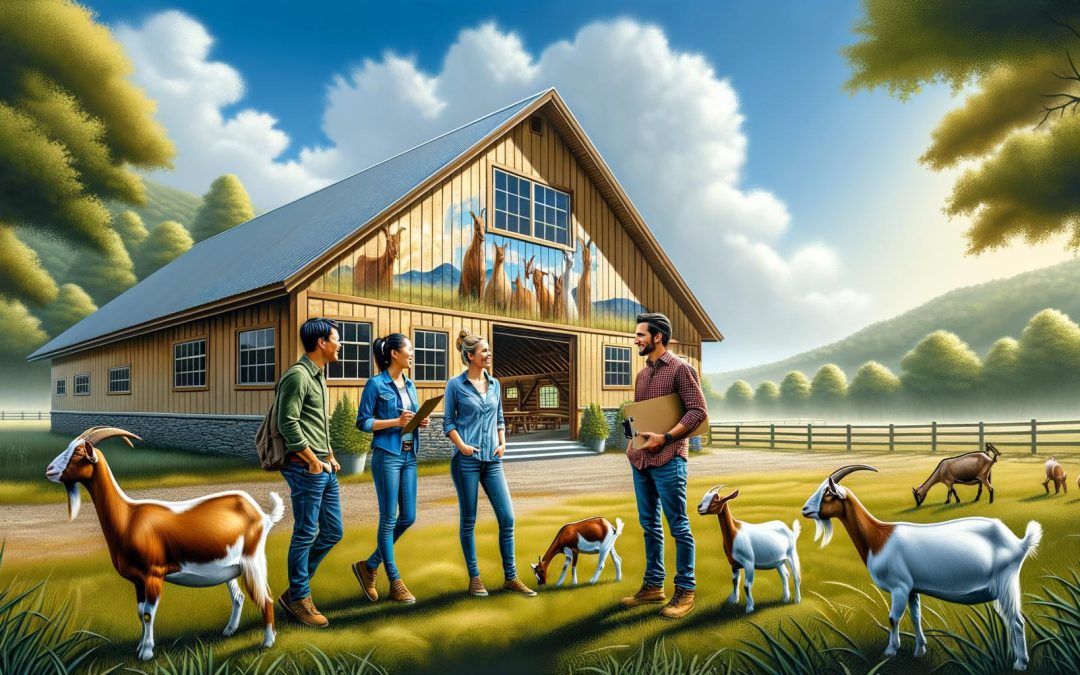Designing the best goat barn for your farm is a critical step in ensuring the health and productivity of your herd. At Outbuilders, we’ve seen firsthand how a well-planned barn can make a significant difference in goat care and management.
The best goat barn designs incorporate essential features like proper ventilation, adequate space, and efficient feeding systems. In this post, we’ll guide you through the key elements to consider when creating a goat barn that meets your specific needs and enhances your farming operation.
What Makes a Goat Barn Effective?
Ventilation: The Breath of Life
Proper ventilation stands as a cornerstone of goat barn design. Goats face susceptibility to respiratory issues, making air quality a top priority. An adult goat comes into contact with approximately 11,000 liters of air in a day. A natural ventilation system with adjustable openings works best. Install ridge vents along the roof peak and eave vents at the sides to create a chimney effect. This allows hot air to escape and fresh air to enter.
Larger barns benefit from additional fans to enhance air circulation. The University of Minnesota Extension recommends at least 100 cubic feet per minute (CFM) of air movement per adult goat during summer months.

Space: Room to Roam
Goats require ample space to move, rest, and socialize. The American Dairy Goat Association provides guidelines for indoor space requirements based on the weight of the animal. Outdoor areas should provide at least 50 square feet per goat.
Your layout should include separate areas for feeding, resting, and kidding. A quarantine area for new or sick animals helps manage herd health and reduces stress.
Flooring: The Foundation of Comfort
The choice of flooring impacts both goat comfort and barn maintenance. Concrete offers durability and easy cleaning but can strain goats’ joints. Consider adding rubber mats in high-traffic areas for extra cushioning.
Packed earth or gravel floors with good drainage serve as effective alternatives. These allow urine to seep away, reducing ammonia buildup. Ensure the floor has a slight slope (about 1-2%) towards a drain for easy cleaning.
Feeding and Watering: Efficiency Matters
Efficient feeding systems save time and reduce waste. Wall-mounted hay feeders keep hay off the ground and minimize contamination. The Penn State Extension recommends 16-20 inches of feeder space per adult goat.
Automatic waterers prove a game-changer for water supply. They ensure constant access to fresh water and reduce labor. Install waterers at a height of about 24 inches for adult goats. Regular checks and cleaning prevent algae growth.
Customization: Tailoring to Your Needs
The most effective goat barns adapt to specific farm requirements. Consider factors like herd size, management style, and local climate conditions. Outbuilders (the top choice for customized farm structures) understands that each farm has unique needs.
Your barn might benefit from additional features such as a milking station, storage areas for feed and equipment, or a dedicated space for veterinary care. The key lies in creating a design that aligns with your farm’s goals and daily operations.
As we move forward, let’s explore the materials that can bring your ideal goat barn to life.
What Materials Make the Best Goat Barn?
Selecting the right materials for your goat barn impacts its longevity, functionality, and the well-being of your herd. Let’s explore the key considerations for choosing materials that will create a durable, comfortable, and easy-to-maintain structure for your goats.
Exterior Materials: Weather Warriors
The exterior of your goat barn must withstand various weather conditions while providing a safe haven for your animals. Wood siding, such as cedar or treated pine, offers natural insulation and allows for easy repairs. However, it requires regular maintenance to prevent rot and insect damage.
Metal siding (particularly steel or aluminum) provides excellent durability and fire resistance. It’s also low-maintenance and can last for decades with proper installation. The downside? Metal can create noise during rain or hail and may require additional insulation to regulate temperature.
Fiber cement siding combines the look of wood with the durability of cement, offering resistance to rot, fire, and pests. While it costs more upfront, its longevity often justifies the expense.
Insulation: Temperature Tamers
Proper insulation maintains a stable temperature inside your goat barn. Fiberglass batts offer good R-value (a measure of insulation effectiveness) for the price. However, moisture and pests can damage them if not properly installed.
Spray foam insulation provides excellent air sealing and moisture control. It works particularly well for irregular spaces and can significantly reduce energy costs. The downside includes higher initial costs and the need for professional installation.
For an eco-friendly option, try cellulose insulation made from recycled paper products. It resists fire and absorbs sound well. However, it can settle over time, which reduces its effectiveness.
Interior Finishes: Clean and Durable Surfaces
The interior of your goat barn should prioritize easy cleaning and durability. Epoxy-coated concrete walls excel for the lower portions of the walls. They resist moisture, clean easily, and withstand the occasional headbutt from an energetic goat.
For upper walls and ceilings, moisture-resistant drywall or fiber-reinforced panels (FRP) work well. These materials resist mold growth and clean easily. Paint them with a semi-gloss or gloss finish for even simpler maintenance.
Avoid bare wood for interior surfaces, as it absorbs odors and resists sanitization. If you prefer the look of wood, opt for sealed, painted, or stained surfaces that you can wipe down easily.
Roofing: Overhead Protection
Your goat barn’s roof serves as its first line of defense against the elements. Polyethylene dome shelters offer exceptional durability with minimal setup requirements. Their curved design effectively sheds snow and water.
Asphalt shingles cost less and allow for easier installation or repair. However, they have a shorter lifespan (typically 20-30 years) and may not perform as well in extreme weather conditions.
For areas with heavy snowfall, try a steeper roof pitch (at least 4:12) to encourage snow to slide off. This prevents excessive weight buildup and potential structural damage.

The right materials for your goat barn balance durability, maintenance, and cost. While some premium materials cost more initially, they often pay off through longevity and reduced maintenance costs. As we move forward, let’s explore how to customize your goat barn to meet your specific needs and enhance its functionality.
How to Customize Your Goat Barn for Maximum Efficiency
Kidding and Quarantine Areas
Separate areas for kidding and quarantine improve herd health. Design kidding pens with 16 square feet per doe. Use solid walls to reduce stress and prevent newborn escapes. Install heat lamps (with protective cages) to keep kids warm.
Isolate quarantine areas from the main herd. Use separate ventilation systems to prevent disease spread.
Feed and Equipment Storage
Efficient storage solutions reduce waste and save time. Install vertical racks for hay bales to keep feed off the ground and maximize space. Store grain in rodent-proof metal containers with tight-fitting lids.
Create a designated area for equipment. Use wall-mounted tool organizers to prevent clutter. Add a small workbench for minor repairs and maintenance tasks.
Milking Station Setup
A well-designed milking station improves efficiency and milk quality. Install non-slip flooring to prevent injuries.
Use a locking headgate system to keep goats still during milking. Place the milking stand near a sink with hot and cold water for easy cleanup. Provide good lighting (50 foot-candles of illumination) in the milking area.
Outdoor Access and Exercise
Goats need outdoor space for exercise and natural behaviors. Create a secure outdoor area with at least 200 square feet per goat. Use sturdy fencing (at least 4 feet high) to prevent escapes.
Include varied terrain in the exercise area. Natural features like rocks or logs offer climbing opportunities. For artificial enrichment, repurpose items (old tires or wooden spools) as climbing structures.

Customization Options
Tailor your goat barn to your specific needs. Consider factors like herd size, management style, and local climate. You might benefit from additional features such as:
- A dedicated veterinary care space
- Automated feeding systems
- Solar panels for energy efficiency
- Rainwater collection systems
If you need help with customized farm structures, Outbuilders (the top choice for farm buildings) understands that each farm has unique requirements.
Final Thoughts
The best goat barn designs balance functionality, comfort, and efficiency. A well-planned barn improves herd health, increases productivity, and reduces labor costs. These benefits allow farmers to focus on growing their operations instead of constantly addressing facility-related issues.
Adaptable barn designs evolve with changing needs as herds grow or farming practices shift. This flexibility ensures that initial investments continue to pay off for years to come. A thoughtfully designed goat barn becomes more than just a shelter; it transforms into a cornerstone of successful goat farming.
At Outbuilders, we understand the importance of creating structures that meet each farm’s unique needs. We help farmers create spaces that truly work for them and their animals through our focus on durability, functionality, and personalized design. Our approach to customization and quality craftsmanship applies to various agricultural structures, including goat barns.







Recent Comments